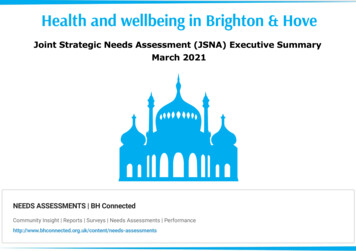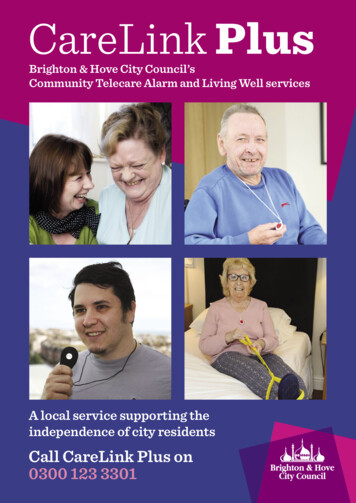
Transcription
Health and wellbeing in Brighton & HoveJoint Strategic Needs Assessment (JSNA) Executive SummaryMarch 2021NEEDS ASSESSMENTS BH ConnectedCommunity Insight Reports Surveys Needs Assessments eeds-assessments
Health and wellbeing in Brighton & HoveJSNA Executive SummaryKey to the summaryThe Brighton & Hove Health and Wellbeing Board is required toproduce a Joint Strategic Needs Assessment (JSNA). The JSNAprovides a description of the current and future health, socialcare and wellbeing needs of the local population, and does so bycollating a variety of evidence, including information fromThroughout the summary (with the exception of thepopulation page) the colours within charts and icons arebased upon whether Brighton & Hove is statisticallysignificantly lower / higher or better / worse thanEngland (where this judgement can be made):existing in-depth needs assessments; health and social care dataand local views and experiences.The JSNA is used to identify local health and wellbeing issuesand inform the commissioning and delivery of local services. Thissummary gives a snapshot of health and wellbeing in the city. Itwill be updated every three months in line with Public HealthOutcomes Framework updates. See the full set of JSNA ds-assessmentsSignificantly lower than EnglandNot significantly different to EnglandSignificantly higher than EnglandSignificantly better than EnglandNot significantly different to EnglandFor the latest information on Covid please visit :Covid-19 key statistics for Brighton & Hove (brighton-Significantly worse than Englandhove.gov.uk)Produced by: Public Health Intelligence Team, Brighton & HoveSignificance cannot be calculatedCity CouncilFor more information: kate.gilchrist@brighton-hove.gov.ukWhere trend data is available, clicking on the icons inthe summary links directly to this information.
KEY ISSUES FOR BRIGHTON & HOVEA range of evidence has been collated for the JSNA to inform the key issues for the city presented here, including informationgained from in-depth needs assessments, data from public health, NHS and social care outcomes frameworks.Issues highlighted are those where we are significantly worse than England (or comparator local authorities), where largenumbers or people are impacted, or where we have significant inequalities:All agesStarting wellWider determinantsHousingHomelessness and roughsleepingTobacco controlRoad safetyActive travelCrime and safetyChild povertyEducationAdverse Childhood Events(ACEs)UnemploymentGood employment andhealthy workplacesFuel povertyIncome deprivationLifestyles / preventionDomestic and sexualviolencePhysical activity, healthyweightFood poverty and goodnutritionEmotional wellbeingRisk taking behaviours andthe clustering of thesebehaviours:SmokingDrugsAlcoholSexual healthEmotional wellbeingSmokingAlcohol and drugs misuseSexual health (STIs andHIV/AIDS)Suicide prevention andself-harmSocial isolation /lonelinessChildren in careEmotional wellbeing andmental ill health supportImmunisationMultiple long-termphysical and mentalhealth conditionsCancer (and cancerscreening)Heart disease and strokeMusculoskeletalconditionsMental healthDementiaMultiple long-termconditionsImmunisationServices / supportDownload dataMental healthPhysical disability andimpairmentLearning disabilitiesLiving wellAgeing wellDying wellSupport for dying in placeof preference
Projectionsliving in the city by 2030 (compared with 2019,an 4% increase to 303,000 people).Population290,900The city’s population is predicted to getolder, with the greatest projected increases by broadresidents (2019)21% Under 20 (24% Eng)62% 20-59 (52% Eng)11% 60-74 (15% Eng)6% 75 (8% Eng)Our population profile is younger than EnglandBrighton & HoveThere are projected to be 12,100 more peopleage band in the 60-69 years (34%, 7,700 extra people)and 80-84 years (34%, 1,800 extra people).Of note, there are projected to be 400 (11%) more 8589 year olds and 300 (12%) more 90 year 203050k100k150k200k250kPopulation (thousands)0-19Download data20-5960-7475 300k
PEOPLEPopulation groupsOur city consists of differentpopulation groups living in arange of geographicalcommunities.One in five people (19.5%) arefrom a Black or Minority EthnicGroup (14.5% South East, 20.2%England)Our best estimate oflesbian, gay andbisexual residents is11% to 15% of thepopulation aged 16 The large student and lesbian,gay, bisexual and trans (LGBT)communities are keycharacteristics of the city’spopulation profile.The most up to date data andour best estimates show:%49,000 residents wereborn outside of the UKBetween 1,500 and2,500 transadults live inBrighton & Hove, withmany more who visitto socialise, studyand/or work17% of the city‘s population inthe year ending June 2020.Higher than the South East(13%) and England (15%)49% of residents have areligion, lower than theSouth East (65%) and England(68%)
PLACEDeprivationOur city is theaccording to the2019 Index ofMultipleDeprivation (IMD)131stIn 2019, 17% of the population of the city lived in the 20%most deprived areas in England and 13% in the 20% leastdeprived areas:Brighton & Hovemost deprivedlocal authority inEngland (of 317)England1 (most deprived)Some areas are more affected by deprivationthan others. The highest concentration ofdeprivation is in the Whitehawk,Moulsecoomb, and Hollingbury areas. Alongthe coast, to the west of the city and inWoodingdean there are also pockets ofdeprivation. All these areas are in the 20%most deprived areas in England2345 (least deprived)
PLACEAir pollution5.3% of adult mortality (30 ) issocial, economic andenvironmental factors:Road safetyestimated to be in fuelpoverty (2018) (10% England)those on the lowest 25%of earnings need 12times their earningto afford the lowest 25%of house prices (2019)64 rough sleepers(Street count 2018)England (City Tracker survey results2018):10057 per 100,000 people killedor seriously injured on the roadsin the city (2016-2018) (43 England)8060Community safety38 per 100,000 peopleadmitted to hospital due toviolent crime (incl. sexualassault) (2017/18 to 2019/20)(46 per 100,000 England)40200lonEPu ng gll la ntoge dtEn h e rgVo lanlu dntEn eerglanGe dtEn ongland11% (14,575 people(5.2% South East, 5.1% England)Brighton & Hove has a strongcommunity with higher rates ofbelonging, pulling together, formalvolunteering and feeling that peoplefrom different backgrounds get on toBeHousing andhomelessnessattributable to particulate airpollution (2018)Community resilience%Our health and wellbeing isinfluenced by a wide range of
STARTING WELLChild poverty16% of childrenlive in povertyenvironmental factors:PopulationThe number of 0-24 year olds isprojected to increase by 6% (5,600)between 2019 and 2030, from93,700 to 99,300 children and youngpeopleThe biggest % increase is expected in15 to 24 year olds, (16%, 8,100 people )13% South East, 17%Children in care74 per 10,000 childrenYouth unemploymentand young people incare. 53 South East, 674.6% 16-17 year olds notin education,employment or trainingEngland (31 March 2020)5.5% England (2018)2019level of development at endof reception. (75% South East72% England (2019)20K40K60K80KPopulation (thousands)0-45-910-1420-24Download data15-19EducationEducational progresspupils make betweenprimary and secondaryschools is in line withthe England average(2018/19)%England (2016)School readiness72% achieving a good2030YearOur children and young people'swellbeing is influenced by a widerange of social, economic andDisabilities andsensory impairmentsThere are 2,153 children andyoung people with a disability orimpairment on the local register(2019/20)It is estimated that there up to 600children and young people with AutisticSpectrum Conditions living in the city
STARTING WELLHealthy weight79% of 4-5 year olds are ahealthy weight -2018/19(England 76%)We do well in many areas: fewer mothers smoke, morebreastfeed and more children are a healthy weight73% of 10-11 year olds a healthyweight - 2018/19 (England 64%)However, we have worse rates of smoking, drinking andHowever, it is estimated that 14,000 children anddrugs use and poorer emotional wellbeing impactingyoung people’s current & future wellbeingMaternal & infant health88% breastfeeding by 48 hoursyoung people in the city are overweight or obeseYoung peopleEmotional wellbeingWe have the highest % of 15 yr olds who519 per 100,000smoke, have tried cannabis and the 3rdhighest drinking weekly in England (2014)and high Sexually Transmitted Infection6% smoking at delivery10% South East and England (2019/20) (STI) rates in young people10-24 yr olds admittedto hospital for self-harm(2018/19)Most childhood immunisations,including MMR at five years(2018/19), are below the 95%required for population protectionsay they often /sometimes havesuicidal thoughts and(17 per 1,000 ,000 (2018)15%B&Under 18 conceptions 13 per%75% England (2016/17)(444 per 100,000 England)17% of 14-16 yr olds10% say that theyoften / sometimes hurtor harm themselves(2018)
LIVING WELLPopulationEmployment and workHealthy life expectancyThe number of 20-64 year olds isprojected to increase by 2% (4,000)2019 to 2030 from 192,300 to196,300 peopleGetting people into, and remainingin, good work is a priority forphysical and mental healthWhilst life expectancy has beenincreasing, healthy life expectancyhas not in recent years. People are2030Year2019The biggest % increase is expected in60-64 year olds (32%, 4,000 people), butfalls in 45-54 year olds (14%, 5,700)40K80K120K4% of 16-64 year olds160KPopulation 960-64Download dataliving longer in ill health. This,4.1% (6,800 people arealongside the rising retirement age,unemployed (Oct 19-Sept 20)means increasing numbers of peopleof working age are living in ill-health.Employment rates are lower for thosewith: long-term conditions; a learningMaleFemaledisability; and those in contact withLife expectancy (2017-19)secondary mental health services(2018/19)79.183.2are out of work due tolong-term sickness (Oct2018 to Sept 2019) 496 the median grossweekly earnings in pounds(2020 Provisional)yearsyearsHealthy life expectancy (2016-18)64.865.9yearsyearsThere are large differences in both lifeexpectancy and healthy lifeexpectancy across the city
LIVING WELLLifestylesSome lifestyle behaviours canhave a negative impact on ourhealth. Smoking, alcohol &drug misuse, and sexualhealth are significant issues inthe city17.5% of adults are currentsmokers (2019)488 per 100,000 peopleEmotional healthBrighton & Hove has higher thanaverage levels of mental healthissues and suicides12% of adults are on GPhad alcohol specific hospitaladmissions in 2018/19practice depressionregisters and 1.2% severemental illness (2019/20)10.0 adults per 1,000 aged 1564 estimated to use opiates and/or crack cocaine (2016/17)14 per 100,000 suicide &physically active residents andfewer obese/overweight adultsactive and 15% inactive(2018/19)16% of adults cycle at leastonce a week, for leisure (7%)and or travel (11%) (2018/19)1510502001- 2003- 2005- 2007- 2009- 2011- 2013- 2015- 2017- However, we have more76% of adults are physicallyRate per 100,000We have the highest rates of new undetermined injury deaths (2017-19),STI diagnosis and HIV prevalence the 4th highest rate in England(2018) outside of London20Brighton & HoveEngland
LIVING WELLLong-term conditionsThere are over50,900 adults(22%) aged 20 withtwo or more long-termphysical or mental healthconditions in the city with a strong link withdeprivation (54% withone or more condition)18,500 (8% of adults)have mental and physicalhealth conditionsWithout scaling upprevention, there will beover 10,500 moreadults with two or moreconditions by 2030Global burden of diseaseHealthy life expectancyLocally, conditions with thegreatest burden (2017) are:Whilst life expectancy has beenincreasing, healthy life expectancyhas not in recent years. People areCancersMusculoskeletal conditionsHeart conditionsNeurological conditions(including dementia)Mental healthCancer screeningtherefore living longer in ill health. This,alongside the rising retirement age,means increasing numbers of people ofworking age are living in ill-health.MaleFemaleLife expectancy (2017-19)79.183.2yearsyearsHealthy life expectancy (2016-18)64.865.9yearsyearsThere are large differences in bothcervical and bowel cancer are all life expectancy and healthy lifeexpectancy across the citylower than England (2020)Screening rates for breast,
AGEING WELLLife expectancy at 65PopulationThe number of 65 year olds isprojected to increase by 20% (7,600)from 38,800 to 46,400 peoplebetween 2019 and 2030The biggest % increase is expected in 8084 years (34%, 1,800 more people). Thereare projected to be 400 (11%) more 85-89year olds and 300 (12%) more 90 yearoldsMale18.421.1yearsyearsFemale64% of those surveyedreceiving adult social carehad good quality of life(2019/20)Similar carer quality of lifeto England (2019/20)2019Social isolationBrighton & Hove has a relatively2030YearLife expectancy at 65 is similar toEngland for females but worsethan England for males (2017-19)Social care10K20K30K40KPopulation (thousands)65-6970-7485-89Download data75-7990 80-84large proportion of older peopleliving alone and a higherpercentage of older people whoare income deprived41% of people aged 65 live alone according to the2011 Census18.7% of older peopleare income deprived(2019)
AGEING WELLDYING WELLWe have similar rates of diagnosed dementia in older people,but higher rates of age-related macular degeneration(preventable sight loss), falls and hip fractures. ImmunisationPlace of deathfor flu in those aged 65 is also worse than England.prefer to die at home. In halfof all deaths (51%), the4.2% of 65 yr94 in every 100,000 65 olds have a recordof dementia(2020)year olds have age-relatedmacular degeneration(preventable sight loss)(2018/19)Flu immunisationThe majority of people wouldplace of death is the place ofusual residence (2017)This is above England and hasincreased from 40% in 2006There were 5% more deaths ofFlu immunisation uptake at 67.9% in 65 year olds85 year olds in winter in the(2019/20) is below the goal of 75% (England 72.4%)period August 2018 to July 2019 thanwould be expected if the rates were thesame as non-winter monthsFalls and hip fractures2,415 per 100,000 people aged 65 wereadmitted as an emergency to hospital due to a fall2019/20 (England 2,222)NEEDS ASSESSMENTS BH Connectedand 597 per 100,000 people aged 65 had aCommunity Insight Reports Surveys NeedsAssessments Performancehip fracture-2019/20 (England sessments
Joint Strategic Needs Assessment (JSNA) Executive Summary March 2021 Health and wellbeing in Brighton & Hove NEEDS ASSESSMENTS BH Connected . Public Health Intelligence Team, Brighton & Hove City Council For more information: kate.gilchrist@brighton-hove.gov.uk . 2 0 1 9 2 0 3 0 20K 40K 60K 80K Y e a r Po p u l a t i o n ( t h o u s a n d .










